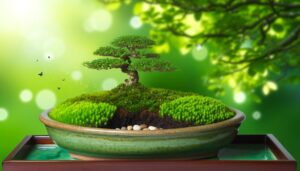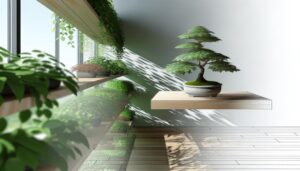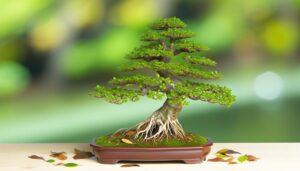Different Styles of Bonsai Trees: Top 3 Timeless Designs
Bonsai trees exhibit various styles that each encapsulate distinct artistic and horticultural techniques. The Formal Upright (Chokkan) style features a straight, tapering trunk with a strong nebari.
In contrast, the Informal Upright (Moyogi) showcases gently curving trunks and balanced branch distribution. The Slanting Style (Shakan) has a tree that grows at an angle, while the Cascade (Kengai) and Semi-Cascade (Han-Kengai) styles mimic trees cascading down cliffs.
The Literati Style emphasizes a slender, twisted trunk with sparse branch placement for dramatic effect. These diverse styles demonstrate the intricate balance of nature and artistry in bonsai.
Discover the nuances of each style.
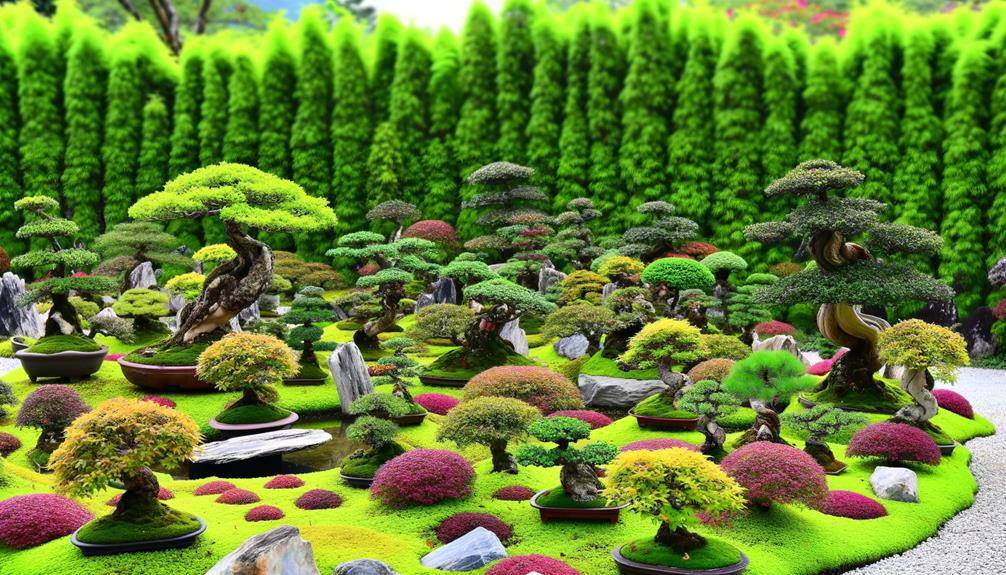
Key Takeaways
- Formal Upright (Chokkan) features a straight, tapering trunk with a strong nebari and follows classical bonsai aesthetics.
- Informal Upright (Moyogi) has gently curving trunks and balanced branch distribution, reflecting natural growth patterns.
- Literati Style showcases tall, thin trunks with dramatic twists, sparse branches, and minimal foliage, highlighting the tree's form.
- Natural Growth Pattern mimics nature with irregular trunk curves and varied branch intervals, celebrating imperfections.
- Subtle Trunk Curves are achieved through pruning and wiring, creating refined, undulating stems and emphasizing visual tapering.
Formal Upright
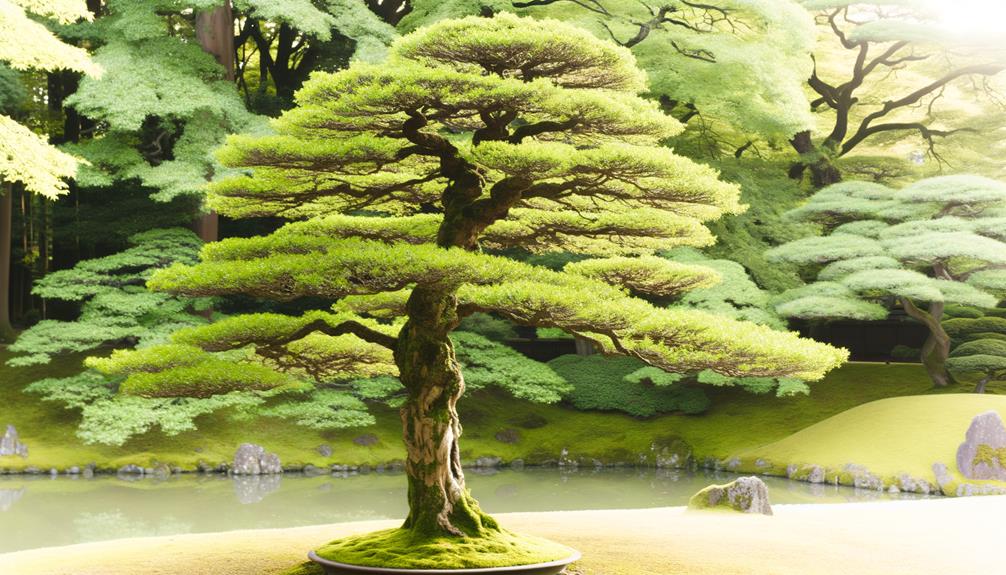
The Formal Upright style, known as Chokkan in Japanese bonsai terminology, is characterized by a straight, tapering trunk that embodies a sense of strength and symmetry, often achieved through meticulous pruning and wiring techniques. This archetype demands a strong, well-developed nebari (root flare) to anchor the visual weight and provide stability.
The primary branches extend horizontally, diminishing in size as they ascend, adhering to a rule of thirds for balanced proportion. Apex growth should culminate in a single, dominant shoot, accentuating the tree's verticality. Leaf and branch placement is meticulously curated to create an open, airy canopy, allowing light to penetrate and nourish interior foliage.
This style epitomizes classical bonsai aesthetics, conveying order and enduring elegance.
Informal Upright
The Informal Upright style, or Moyogi, emulates the natural growth patterns of trees shaped by environmental factors, displaying gently curving trunks that create visual interest.
This style achieves a harmonious balance through carefully considered branch distribution, ensuring each branch is aligned with the tree's overall aesthetic and structural integrity.
The subtle curves of the trunk are pivotal in conveying the tree's dynamic movement and resilience, making the Informal Upright a favored choice among bonsai enthusiasts seeking to capture nature's elegance.
Natural Growth Pattern
In the world of bonsai artistry, the Natural Growth Pattern, also known as the Informal Upright style, epitomizes a harmonious blend of structured form and organic fluidity. This style is characterized by a trunk that rises with gentle, irregular curves, creating a naturalistic, yet aesthetically pleasing appearance.
Branches emerge at varied intervals, mimicking the unpredictable growth found in nature. To achieve this look, bonsai artists must meticulously prune and wire the tree, ensuring each branch contributes to the overall balance and proportion.
This style often employs species with flexible trunks, such as Japanese Maple or Juniper, to accentuate the fluidity of the design. The Informal Upright style ultimately celebrates the intrinsic beauty of nature's imperfections.
Subtle Trunk Curves
Characterized by its refined, undulating stem, the Subtle Stem Curves within the Relaxed Upright style demand a nuanced understanding of both horticultural techniques and aesthetic principles. This bonsai style emulates the natural growth of trees that have faced varying environmental conditions, resulting in a stem that gently curves, rather than growing in a strictly vertical manner.
The key to achieving this effect lies in meticulous pruning and wiring, allowing the stem to develop its graceful bends over time. Attention to tapering, where the stem gradually narrows from base to apex, is vital to enhance visual appeal. The interplay of light and shadow created by these curves further accentuates the tree's dynamic form, making it a captivating focal point in any bonsai collection.
Branch Distribution Balance
Achieving a harmonious Branch Distribution Balance in the Informal Upright style necessitates a strategic arrangement of branches that guarantees both aesthetic appeal and structural integrity. The branches should emanate from the trunk at intervals that promote visual equilibrium and horticultural resilience.
Key principles include:
- Primary Branching: The first branch should emerge one-third up the trunk, providing foundational stability.
- Secondary Branching: Subsequent branches should be staggered, avoiding direct vertical alignment to establish sunlight penetration and airflow.
- Tertiary Branching: Smaller branches must fill spaces without overcrowding, contributing to a naturalistic appearance.
- Apex Formation: The topmost branch should be the smallest, guiding the viewer's eye upward while preserving proportional balance.
This meticulous approach nurtures both artistic beauty and botanical health.
Slanting Style
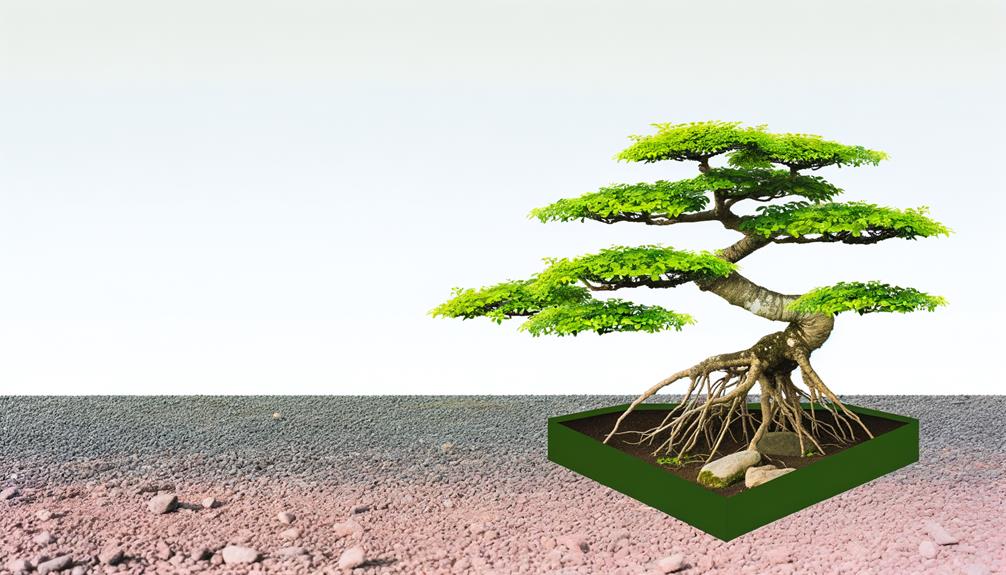
The Slanting Style, or Shakan, is characterized by a trunk that leans to one side, typically at an angle between 60 to 80 degrees from the ground.
This style requires careful care to guarantee the tree maintains balance and visual harmony, often requiring strategic pruning and wiring to guide growth.
Attention to root placement and anchoring is vital to prevent toppling and to support the tree's dynamic yet stable posture.
Trunk Angle Characteristics
In the slanting style of bonsai, the trunk emerges from the soil at an oblique angle, typically between 45 and 60 degrees, creating a dynamic visual tension that suggests the influence of natural forces such as wind or uneven light exposure. This particular style, known as 'Shakan,' demands careful attention to several key aspects:
- Root Anchorage: Ensuring a strong root system to support the tilted trunk.
- Trunk Line: Maintaining a consistent taper and curvature to emulate natural growth.
- Branch Distribution: Strategically positioning branches to balance the visual weight.
- Apex Orientation: Directing the apex towards the slanted direction to enhance realism.
These characteristics contribute to the artistic and technical mastery required to create a compelling slanting bonsai, embodying both aesthetic appeal and horticultural precision.
Care and Maintenance
How does one guarantee the sustained health and aesthetic integrity of a slanting bonsai tree?
To start with, make sure optimal drainage by using a well-balanced soil mix, preventing root rot.
Regular pruning is essential; focus on maintaining the tree's asymmetrical balance, removing excess foliage and branches that disrupt its natural slant.
Wiring techniques are vital to guide the trunk and branches into the desired position, but careful attention must be paid to avoid wire marks.
Watering should be consistent yet moderate, avoiding both drought and waterlogging.
Fertilization should be tailored to the tree species, using slow-release organic options to promote gradual growth.
To conclude, rotating the bonsai occasionally ensures even light exposure, important for uniform foliage development and structural integrity.
Cascade Style
Cascade style bonsai, known as 'Kengai' in Japanese, emulates trees that grow on steep cliffs or mountainsides, with branches and trunk cascading downward in a dramatic, gravity-defying manner. This style presents unique challenges and requires meticulous attention to detail to achieve its aesthetic goals.
Key elements include:
- Trunk Formation: The trunk must angle sharply downward from the base, often exceeding the height of the pot.
- Branch Placement: Branches should extend horizontally or downward, mimicking natural growth patterns influenced by gravity.
- Pot Selection: Deep pots are necessary to balance the visual weight and provide stability.
- Wiring Techniques: Advanced wiring is essential to guide the downward growth and maintain the desired shape.
Understanding these elements guarantees the successful creation of authentic Kengai bonsai.
Semi-Cascade Style
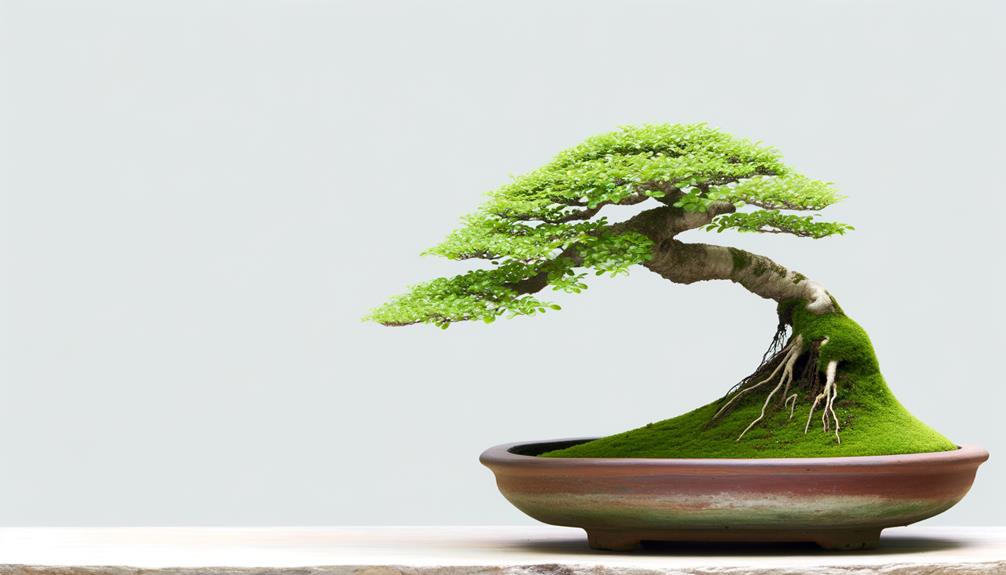
The Semi-Bend style, or 'Han-Kengai', represents trees that grow on gentler slopes, where the trunk and branches descend below the rim of the pot but do not extend as far downward as in the full Cascade style. This style captures the dynamic tension between stability and movement, often featuring a trunk that bends gracefully before the apex points upward.
The visual balance is essential; the tree must convey a sense of natural growth while maintaining proportion and harmony. Key elements include a strong, tapering trunk and well-defined primary and secondary branches, which should be carefully pruned to enhance the overall aesthetic. Typically, deeper pots are used to support the tree's lower center of gravity, ensuring both visual and structural stability.
Literati Style
Embodying a minimalist aesthetic and inspired by the rugged, wind-swept trees found in nature, the Literati style, or 'Bunjin-gi', emphasizes elegance through simplicity and the expressive form of the tree's trunk and branches. This style is characterized by a slender, often contorted trunk with sparse foliage, showcasing the tree's stark beauty.
Key elements include:
- Trunk Design: Typically tall and thin, with dramatic twists and bends.
- Branch Placement: Sparse, asymmetrical branches that highlight the trunk's form.
- Foliage: Minimal foliage, usually near the apex, to accentuate the tree's structure.
- Pot Choice: Simple, understated pots that do not detract from the tree's artistry.
This style requires a deep understanding of bonsai aesthetics and mastery of horticultural techniques.
Conclusion
The diverse styles of bonsai trees—Formal Upright, Informal Upright, Slanting Style, Cascade Style, Semi-Cascade Style, and Literati Style—reflect the rich tapestry of artistic expression and horticultural mastery.
Much like the intricate brushstrokes of a master painter, each style encapsulates distinct philosophies and meticulous techniques.
For instance, the Literati Style, with its minimalist elegance, mirrors the delicate balance found in traditional Japanese ink wash paintings, where simplicity belies profound depth and complexity.
This multifaceted art form continues to captivate and inspire.


